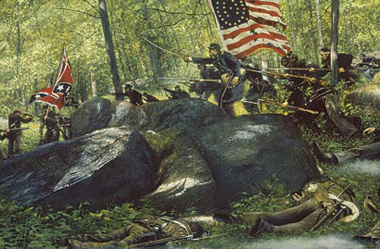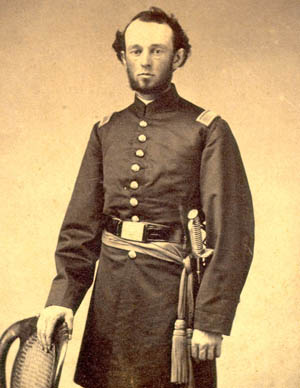Commemorating its Past: UAlbany Students, Faculty and Alumni Battled in Gettysburg
 |
|
UAlbany students, faculty and alumni took part in the Battle of Gettysburg, including Little Round Top, in 1863.
|
It is often regarded as the turning point of the Civil War: the Battle of Gettysburg, fought 150 years ago in and around the small Pennsylvania town, ended General Robert E. Lee’s invasion of the North, and ultimately helped propel Union forces to victory in the war and abolish slavery in the United States. Among the 165,000 troops who fought in the battle were at least a dozen students from the Albany State Normal School – a teacher’s college in upstate New York that would eventually become the University at Albany.
The students would serve on the front lines in the battle, helping hold the Union line at Little Round Top on July 2, 1863, where a Confederate victory might have dramatically altered U.S. history. Among them, Normal School alumnus Private Elbert Traver, ’62, from Rhinebeck, N.Y. and undergrad Private George B. Wolcott, from Milan, N.Y., were both killed at the Battle of Gettysburg.
The largest regimental monument at Gettysburg is dedicated to the 12th and 44th New York Infantry Regiments, which included the Normal School Company. A tablet on one side of the monument at Gettysburg notes that in October 1862, two full companies - one of Normal School students and the other from Yates County, N.Y. - were added to the 44th New York Infantry.
 |
|
UAlbany Professor and alum Albert Husted, '55, helped organize the Normal School Company in 1862.
|
After Lee’s defeat of the Union in the Peninsula Campaign in July of 1862, two math professors, Albert N. Husted, ’55, and Rodney G. Kimball, founded the Normal School Company, known as New Company E of the 44th New York Volunteers. Husted and Kimball recruited students, who dropped their books and shouldered muskets. They were nicknamed “Ellsworth’s Avengers,” for Elmer Ellsworth of Mechanicville, N.Y., a friend of Abraham Lincoln and the first Union casualty in the Civil War. The company numbered 100 men, including 25 undergraduates and alumni.
In the week before the conflict, the men marched 100 miles and were beginning to look tired and worn. They recovered just in time. “You naturally inquire as to how it came to pass that so many brave Texans could be ‘gobbled up’ by so small a force of Yanks,” wrote Husted in Gettysburg in Perspective. “Our men were somewhat protected by large rocks and boulders, and, not far in front of the Union line were other rocks and boulders, which afforded considerable protection for the advancing foe, but from which it was very dangerous to retire when the main line retreated.”
During the battle, about six men led by Normal School graduate Consider H. Willett ’62 of Onondaga, N.Y., “sprang forward and received the surrender of the ninety Texans, who found themselves caught as in a trap,” wrote Husted. Willett was promoted to Captain, and transferred to the U.S. Colored Infantry.
As Husted rounded up the prisoners to take them to the rear, one Rebel soldier “stood directly in front of me begging me not to shoot him, when a bullet, from the musket of a brother Texan, entered his back. Probably he saved my life, or, at least, protected me from a severe wound.”
UAlbany alum Corporal Thompson Barrick from Geneva, N.Y., was a flag bearer who survived a bullet wound to the neck and shoulder while carrying the colors.
In addition to the Normal School Company, there were other graduates and students who joined other regiments.
According to UAlbany alum Chris Hunter (M.A. in history, 2000), curator of Collections and Exhibitions at the Museum of Innovation and Science in Schenectady, the highest ranking was Major General Henry Slocum, who commanded the Union 12th Corps. Slocum attended in the 1840s and left to attend West Point. In addition, four others from the Normal School fought on the Confederate side, and one of them was killed.
UAlbany Professor of History Allen Ballard has taught a graduate research seminar on the Normal School Company, and wrote Where I’m Bound (2000), the first novel about African-American soldiers who fought in the Civil War. The book is based on the true story of the 3rd Colored U.S. Cavalry troops. In a 1999 New York Times editorial, Ballard described the conflicting emotions he felt at Gettysburg, noting that black volunteers who sought to fight at Gettysburg were turned back en route to the battle.
Ballard also noted the bravery of the Normal School volunteers, who fought near Col. Joshua Chamberlain’s 20th Maine Volunteer Regiment at Little Round Top, where the Union forces repulsed several Confederate assaults on July 2, 1863. The Normal School Company helped to hold the center of the line in defending the hill.
Ballard wrote how critical the victory was in repelling Lee and sending his forces retreating to the South, never again to set foot in Union territory. As Ballard states, had the Union lines been broken at Gettysburg the following afternoon at Cemetery Ridge during Pickett’s charge, slavery might have continued in the South for generations.
Instead, the site would host President Lincoln on the afternoon of Thursday, November 19, 1863, to dedicate the Soldier’s National Cemetery and to deliver perhaps the most well-known speech in American history -- the Gettysburg Address:
Four score and seven years ago our fathers brought forth on this continent a new nation, conceived in liberty, and dedicated to the proposition that all men are created equal.
Now we are engaged in a great civil war, testing whether that nation, or any nation so conceived and so dedicated, can long endure. We are met on a great battlefield of that war. We have come to dedicate a portion of that field, as a final resting place for those who here gave their lives that that nation might live. It is altogether fitting and proper that we should do this.
But, in a larger sense, we can not dedicate, we can not consecrate, we can not hallow this ground. The brave men, living and dead, who struggled here, have consecrated it, far above our poor power to add or detract. The world will little note, nor long remember what we say here, but it can never forget what they did here. It is for us the living, rather, to be dedicated here to the unfinished work which they who fought here have thus far so nobly advanced. It is rather for us to be here dedicated to the great task remaining before us—that from these honored dead we take increased devotion to that cause for which they gave the last full measure of devotion—that we here highly resolve that these dead shall not have died in vain—that this nation, under God, shall have a new birth of freedom—and that government of the people, by the people, for the people, shall not perish from the earth.
![]() For more news, subscribe to UAlbany's RSS headline feeds
For more news, subscribe to UAlbany's RSS headline feeds
A comprehensive public research university, the University at Albany-SUNY offers more than 120 undergraduate majors and minors and 125 master's, doctoral and graduate certificate programs. UAlbany is a leader among all New York State colleges and universities in such diverse fields as atmospheric and environmental sciences, business, education, public health,health sciences, criminal justice, emergency preparedness, engineering and applied sciences, informatics, public administration, social welfare and sociology, taught by an extensive roster of faculty experts. It also offers expanded academic and research opportunities for students through an affiliation with Albany Law School. With a curriculum enhanced by 600 study-abroad opportunities, UAlbany launches great careers.


